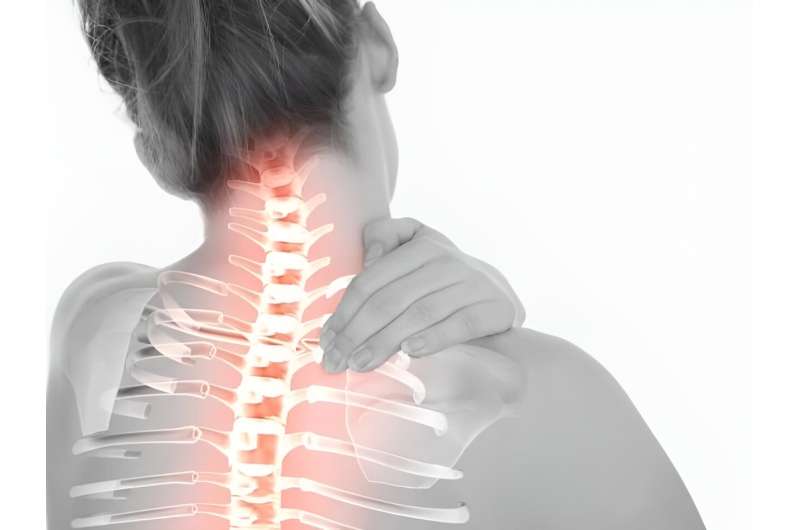This article has been reviewed according to Science X's editorial process and policies. Editors have highlighted the following attributes while ensuring the content's credibility:
fact-checked
peer-reviewed publication
reputable news agency
proofread
Researchers explore new nonaddictive means of fighting pain

New research shows that an experimental drug fine-tuned to a specific pain pathway can ease post-surgery aches, a finding that may eventually offer an alternative to highly addictive opioids.
The pill, known for now as VX-548, targets a particular sodium channel that is active only in the body's peripheral sensory nerves, where it helps transmit pain signals to the brain. The idea is that inhibiting the channel might ease pain without serious systemic side effects—including the risk of addiction and abuse associated with opioids.
In an early trial, researchers found some promising evidence that the drug can take the edge off of post-surgery pain.
Among 577 patients undergoing bunion surgery or tummy tucks, those given the highest dose of VX-548 got more pain relief over the next 48 hours, versus those given a placebo pills. And the side effects, mainly headache and constipation, were on the mild side.
The findings, published Aug. 2 in the New England Journal of Medicine, are not the final word on the medication. An ongoing phase 3 trial is comparing the effectiveness of VX-548 against a standard opioid painkiller.
"But these findings are an important step forward in showing proof-of-principle," said Dr. Stephen Waxman, a professor of neurology and neuroscience at Yale University School of Medicine.
Waxman, who was not involved in the trial, wrote a commentary that was published with the findings and gives an overview of the science behind the experimental drug.
"Sodium channels are the molecular batteries that allow neurons [nerve cells] to communicate," Waxman explained.
The concept of blocking sodium channels to disrupt pain signaling is not new or exotic. Ordinary novocaine works that way, Waxman said.
But novocaine, and similar drugs like lidocaine, are "nonselective" in blocking sodium channels. If they were given by pill, they would affect sodium channels indiscriminately, including those in the heart and brain. So the drugs are given by injection, into the area where pain relief is needed.
Not all that long ago, no one knew there were sodium channels that act only in the peripheral sensory nerves. But, Waxman said, the discovery of multiple sodium-channel genes raised the possibility that there were such channels. At this point, scientists have identified three: 1.7, 1.8 and 1.9.
The new drug, being developed by Boston-based Vertex Pharmaceuticals, goes after the 1.8 channel.
To see whether that translates into relief from acute pain, Dr. James Jones and colleagues at Vertex and several U.S. medical centers ran two trials: One included 303 patients having abdominoplasty (a tummy tuck). After surgery they were randomly assigned to receive VX-548 (at either a high or moderate dose), a standard opioid (hydrocodone plus acetaminophen) or placebo pills for 48 hours.
The other trial involved 274 patients having bunion surgery. They, too, were randomly assigned to take either VX-548 (at one of three doses), hydrocodone/acetaminophen or placebo for 48 hours.
Overall, only the highest dose of the drug proved better than placebo pills, reducing patients' pain intensity scores to a greater degree over two days.
The trial was not designed to test VX-548 against hydrocodone/acetaminophen, but there were some positive signals, said Dr. Mark Wallace, a pain medicine specialist at the University of California, San Diego.
For one, the experimental drug seemed to cause fewer side effects, Wallace writes in a second editorial published with the study. And fewer patients on VX-548 discontinued it because it wasn't working, versus patients on opioids.
But, Wallace cautions, "limited conclusions" can be made about the drug's pain-relieving effects compared with opioids. He described the study as "an early foray into an exciting new class of drugs in a difficult field."
In the face of an ongoing opioid crisis, an effective pain medication with low addiction potential would be welcome. Based on the mechanism of action, Waxman said, VX-548 would not be expected to be addictive.
He also stressed, however, that a lot of research remains to be done. That includes bigger-picture questions, such as whether targeting more than one peripheral sodium channel could be more effective at pain relief.
And while the latest study focused on post-surgery pain, there are other, difficult-to-treat forms of pain.
A Vertex spokesperson said the company has started an early trial of VX-548 for neuropathic pain. That's pain caused by nerve damage, such as diabetic neuropathy.
Waxman said the need for new neuropathic pain therapies is "great," and peripheral sodium channels should be studied as targets for treatment. But any such therapy would be down the road.
"I'm confident that we will have a new class of nonaddictive pain medications," Waxman said. "But it will take some time."
More information: Jim Jones et al, Selective Inhibition of NaV1.8 with VX-548 for Acute Pain, New England Journal of Medicine (2023). DOI: 10.1056/NEJMoa2209870
Stephen G. Waxman et al, Targeting a Peripheral Sodium Channel to Treat Pain, New England Journal of Medicine (2023). DOI: 10.1056/NEJMe2305708
2023 HealthDay. All rights reserved.



















